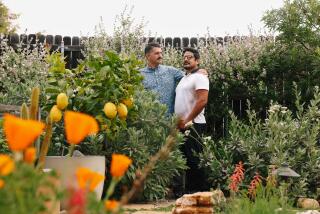What’s In and What’s Out in Houseplants
Although the raising of houseplants has grown to be the No. 1 interest among Southern California gardeners over the past 20 years, the kinds of indoor plants people are growing has changed considerably over the same period.
According to Windy Overbach, president of Rolling Greens Inc., one of the Southland’s biggest indoor plant wholesalers, houseplants come in and out of favor just as frequently as fashion and food.
Overbach, who began his plant career almost 20 years ago as manager of the legendary “Mother Earth Plant Boutique,” the now-defunct Melrose Avenue shop that spawned the indoor plant business as we know it today, recalls the early ‘70s:
“Back then, people were just getting into plants. Their main concern was buying plants that would live. Nowadays, everybody has a houseful of dracaenas and philodendrons and they’re drifting toward more exotic and colorful things.”
My own experience bears this out. The people who write me letters and the folks who call me on the radio are asking very different kinds of questions from 20 years ago. The majority of the queries used to concern dieffenbachias and pothos and palm trees, and the like; nowadays they’re more likely to be about bonsai plants or orchids.
“There’s no doubt people are more adventurous today than they used to be,” says Victor Barba, whose St. Marie’s Garden has been in business in West Los Angeles for 19 years.
Barba remembers the beginnings of the plant boom. “Everybody’s main concern was making sure the plant they bought would live a long, long time if they took care of it properly. Now, when I tell people a certain plant might not make it more than a couple of months, they just shrug and say, ‘Well, it’s a lot cheaper than cut flowers.’ It seems that people today want instant gratification, an impact right now.”
This fickle nature of plant buyers has not gone unnoticed by plant breeders and growers, who are constantly striving to hybridize new and different variations on the more familiar themes to keep the consumer interest level up.
“New varieties come on the scene all the time,” Overbach says, “and they keep getting better looking, stronger and longer-lasting.”
Overbach has 10 varieties of spathiphyllum, for instance, at his Culver City greenhouse, and says that he’s expecting several exciting new plants in the next few months.
“There’s a new dracaena in production that’s a mix between a D. craigii and a D. fragrans that’s just spectacular,” says Overbach, “and I’ve just gotten a new Chinese evergreen that I think will be a terrific seller.” Another very hot plant, Overbach says, is the “China doll” (Radermachera sinica), which was introduced into the local marketplace about three years ago.
“Color is the name of the game,” says Jerry Robinson, vice president and co-owner of Rainforest Flora Inc., one of Los Angeles’ largest wholesale distributors of exotic plants. “People still buy tons of green foliage plants to use as home and business decor, but more and more people are adding colorful plants to their collections as well.”
Robinson, who with his partner, Paul Isley, has been in business for 15 years, feels that bromeliads, especially the genus Neorgelia, are the plants of the future. “Bromeliads give people the chance to have color in their home even in low-light spots. And, a bromeliad’s color will last for months and months.”
Another trend that Robinson finds interesting is that supermarkets and discount stores, even warehouse clubs such as Costco and the Price Club are now adding bromeliads and even orchids to their indoor plant inventories.
Speaking of plants and supermarkets, Overbach, Barba and Robinson all agreed that the biggest change in the plant business over the past 20 years is that more houseplants are sold at the supermarkets these days than anywhere else.
“If you really know what you’re doing, there are some terrific bargains at the supermarkets,” Barba said. “But you’re still better off buying your plants at a nursery or garden center. Supermarkets can’t maintain the plants as well as we can, and often they’re brought in for sale before they’re ready.”
A check of several local flower shops, nurseries and garden centers revealed some interesting facts about which plants the consumer is favoring these days:
Cactus plants and cactus dish gardens are very much in. According to nursery people, a lot of this has to do with the current popularity of Southwestern decor, and much has to do with the fact that cactus and succulents are extremely drought-resistant plants.
Bonsai plants are another red-hot horticultural item. George Yamaguchi, owner of Yamaguchi’s Bonsai Nursery in West L.A. reports bonsai-buying is up enormously in the past two or three years.
Almost all the nurseries and flower shops I visited also reported a huge upsurge in bonsai sales in the last couple of years, and I can understand why: A beautiful bonsai tree is indeed a living work of art--but remember, most bonsais prefer to be kept outdoors; only bring your bonsai plant inside when you want to show it off for friends.
Ferns are out. The biggest problem in the fern market, according to Jerry Robinson, is a lack of new varieties. “People have gotten tired of seeing the same old Boston ferns and bird’s-nest ferns,” says Robinson. “Interest has really died down.”
Topiary is in. Not only the molded animal figures or geometric shapes, but little ball-topped herb plants as well.
These little herb topiaries, which some botanists might call “small standards” (a standard is a plant that has been trained into a slim, bare-trunked tree with a rounded bushy top), are just coming into favor and are very difficult to find.
Orchids are in. “Up until a couple of years ago, people were terrified to buy orchids,” Barba says. “They thought it was impossible to grow orchids unless you had a greenhouse. But suddenly people have come to know that orchids such as cymbidiums, cattleyas and phalaenopsis will do very well in their homes, and they’re buying them like crazy.” Another factor in the upsurge of orchid sales is the fact they’ve come down quite a bit in price due to increased production.
Although foliage plants are still the mainstay of the business, some once very popular plants are almost completely out of favor these days. Rubber trees, snake plants and aspidistras, for instance, are very slow movers.
And although weeping fig trees (Ficus benjamina) remain very much a staple of indoor decor, a new variegated variety and “standards” with braided trunks are much more in demand than the more common green-leafed version.
One thing is for sure: Some plants will come and others will go, but plants of one kind or another will always be part of our lives and our indoor decor.






